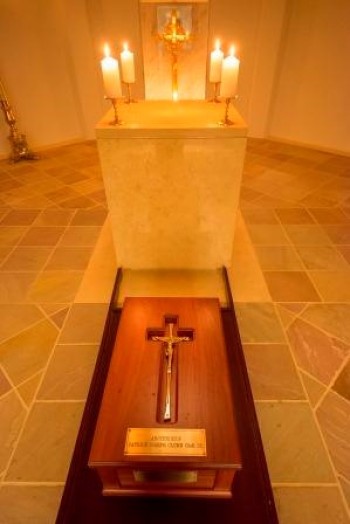Archbishop Clune CSsR Reinterred in St Mary's Cathedral
On Tuesday 3 September 2013, around five hundred relatives, dignatries, clergy and parishioners of the Archdiocese of Perth, together with members of the Redemptorist Community of North Perth, gathered in St Mary's Cathedral for the reintement of the human remains of Perth's fourth Bishop and first Archbishop, The Most Rev Patrick Joseph Clune CSsR DD, in the Cathedral crypt.
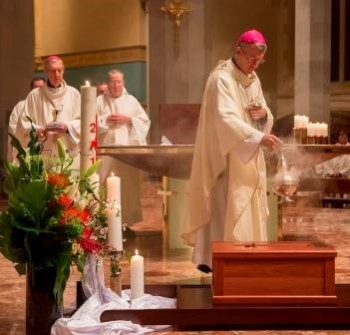
It brought to a conclusion the process that began in 2009 of reinterring all seven of the former and deceased bishops and archbishops of Perth, namely, Bishop John Brady, Bishop Martin Griver Y Cuni, Bishop Matthew Gibney, Archbishop Patrick Clune, Archbishop Raymond Prendiville, Archbishop Launcelot Goody and Archbishop William Foley.

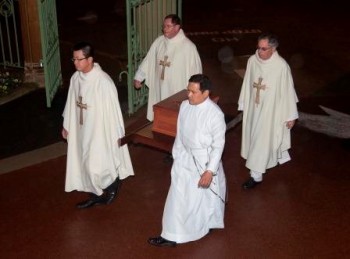

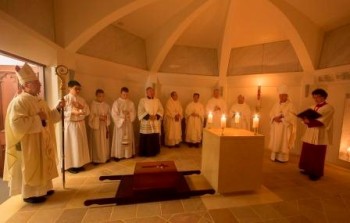

In his homily, Archbishop Timothy Costelloe SDB expressed his particular gratitude to the Redemptorist Order, of whom Archbishop Clune was a member, for their willingness to agree to the request of the Clune family that the body of their relative and the former Archbishop of Perth be exhumed from the Redemptorist section of Karrakatta Cemetery and reinterred in the Cathedral Crypt.
The text of Archbishop Costelloe's homily follows:
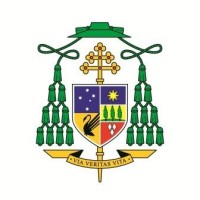
I would like to begin my few reflections this evening by expressing my gratitude to the Redemptorists of the Australian Province for their willingness to agree to the request of the Clune family, and that of the Archdiocese, to be able to reinter the remains of their confrere, Archbishop Patrick Joseph Clune, in the crypt of our beautiful cathedral. I know that it was not an easy decision to make and I would imagine that it was made with some reservations. Different people have told me that the older members of the Province were particularly alive to the memory of Archbishop Clune expressing his desire to be buried with his Redemptorist confreres at Karrakatta cemetery, and there was a strong conviction that this request should be honoured. At the same time, and especially with the redesigning and completion of the Cathedral, there has been a growing desire for the Archbishop to rest among his brother bishops in the crypt. It is especially significant that Archbishop Clune be reburied here in his cathedral just a few days after the one hundredth anniversary of the erection of the diocese of Perth as the metropolitan archdiocese of the Province of Western Australia. It was Archbishop Clune, the fourth bishop of Perth, who had convinced the authorities in Rome that the time had come for Western Australia to assume its proper and independent place within the Church in Australia. And it was he who suggested that the new Province incorporate the whole of the state of Western Australia. Thus, on August 28, 1913, Bishop Clune, the fourth bishop of Perth, became the first archbishop of Perth. It is also very important, I think, that Archbishop Clune should rest here in the Cathedral for it was he who, on the 25th of April in 1926, laid the foundation stone of the new neo-Gothic cathedral in which we find ourselves this evening.
Archbishop Clune’s desire to be buried among his Redemptorist confreres points to an essential dimension of his life and spirituality which I would like to reflect on briefly. The Archbishop’s biographer, Fr Christopher Dowd who is with us this evening, has remarked that at heart the archbishop was always a Redemptorist. Throughout his time as both bishop and archbishop of Perth he always maintained close relationships with his confreres at the monastery in North Perth and whenever he had to go to Rome he invariably stayed at the Redemptorist General House. As he approached the end of his life he asked a Redemptorist priest, Father Bernard Gorey, to prepare him for his death. And perhaps most significantly of all he renewed his vows as a Redemptorist on his death bed. He had been profoundly shaped by the spirituality of St Alphonsus and it was not something that he wished to, or could, lay aside.
It can help us then to understand Archbishop Clune, and the great gift he has been to the archdiocese of Perth, if we reflect for a moment on the spirituality and mission of the Redemptorists. In their Constitutions, their Rule of life, we read this:
Strong in faith, rejoicing in hope, burning with charity, on fire with zeal, in humility of heart and persevering in prayer, Redemptorists, as apostolic men and genuine disciples of St Alphonsus, follow Christ the Redeemer with hearts full of joy; denying themselves and always ready to undertake what is demanding, they share in the mystery of Christ and proclaim it in Gospel simplicity of life and language, that they may bring to people plentiful redemption.
When you read the story of Archbishop Clune, it is precisely these qualities which stand out. He is remembered, for example, as being a “happy man”. He was warm, welcoming, affable and approachable. These are very attractive human qualities, of course, but carrying the heavy responsibilities he did, we must believe that these qualities were also special gifts of grace, given to a man who was indeed, as a genuine disciple of Saint Alphonsus, a follower of Christ with a heart full of joy. It was surely Archbishop Clune’s great faith in God, nourished in his family and deepened through his life and ministry as a Redemptorist, which enabled him to carry the responsibility of his office with such grace. As we remember him tonight, we find ourselves invited to allow God to be more and more at the heart and soul of our daily lives, as he was in the life of Archbishop Clune.
Redemptorists, too, are men who are always ready to undertake what is demanding in order to proclaim the gospel of Christ. This was certainly true of Archbishop Clune. His impact on the life of the archdiocese of Perth in the twenty-five years of his episcopate is remarkable. Many of you would know much better than me how much the Church in Perth owes to his vision, his hard-work, and his fidelity and perseverance. He steered the Church through the difficult years of the First World War and the Great Depression which followed. He negotiated the difficult terrain of a culture which was not always accepting of Catholics and a society which was not marked by the good relations among Christian denominations which we enjoy today. And yet, he regarded the Anglican archbishop of Perth, Dr Charles Riley, as a close friend, sought to collaborate with protestant ministers and with the Jewish leaders in Perth, and was fully involved in the public life of the city. The difficulties and challenges he faced in his time as bishop and archbishop never led him to abandon his belief in the fundamental goodness of every person. He was, as the Redemptorist Constitutions express it, a man who was “strong in faith, rejoicing in hope, burning with charity, on fire with zeal, humble in heart and persevering in prayer”. These, of course, are not just Redemptorist qualities. They are qualities which all of us are called to bring alive in our own lives. It is Archbishop Clune’s great gift to us that he has modeled them for us.
Tonight, as we reinter the human remains of Archbishop Clune in the crypt of the Cathedral whose foundation stone was laid and blessed by him, we remember not just him but all those men and women, some of whom we recall by name but most of whom are in a sense known only to God, whose hard work, faith, courage and fidelity have bequeathed to us not just the material dimension of our archdiocese but much more importantly our faith. They are the men and women, laity, religious and clergy, upon whose shoulders we stand. They are the ones who enable us to look forward with hope, even in the midst of the many challenges we face at this present moment in our history. Sometimes we can be overwhelmed by these challenges, just as Archbishop Clune must have been tempted at times to feel overwhelmed by all that he was confronting. Perhaps then, among the many gifts his life offers us, we might remember the motto he chose for his consecration as a bishop: Salve, spes nostra – Hail, our hope. The words come from the Hymn Salve Regina. “Hail Holy Queen, Mother of mercy. Hail our life, our sweetness and our hope.” As a Redemptorist Archbishop Clune would have had a great devotion to Our Lady of Perpetual Help. Indeed he incorporated her image in his episcopal crest. Tonight he invites us, as true disciples of Jesus, to look to her, the Mother and helper of the Church, and entrust ourselves to her prayer in great hope. As Archbishop Clune would have prayed so often so let us pray too, “Holy Mary, mother of God, pray for us sinners, now and at the hour of our death. Amen.”
